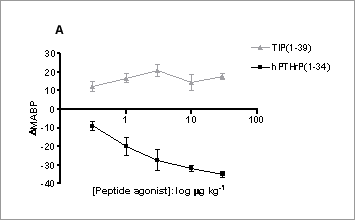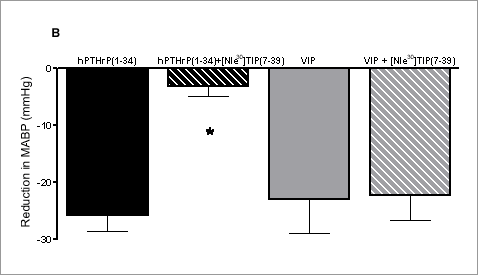Characterisation of responses to parathyroid hormone related protein in the rat: measurement of mean arterial BP Parathyroid hormone related protein (PTHrP)(1-34) causes transient hypotension in animals (Charbon 1968; Pang et al., 1980; Nickols et al., 1989). By administering hPTHrP(1-34) (i.v. bolus) to anaesthetised rats and measuring MABP we aimed to characterise this response using the PTH1-receptor antagonist [Nle30] TIP(7-39) (Roberts et al. 2005). Methods: Male Wistar rats (250-350g) were anaesthetised with urethane. All animals received a tracheotomy and both jugular veins were cannulated. The carotid artery was also cannulated the catheter of which was connected to a pressure transducer attached to a Powerlab data acquisition system with data collected using Chart 4.0 software. Each animal received an i.v. infusion of heparinised saline (50U ml-1) at 1.27 ml h-1 . A nimals were transferred to a heated blanket and allowed to recover. Responses to PTH-ligands were obtained following i.v. bolus (0.2ml dose volume, followed by 0.4ml saline ‘flush’). Results: Typically, hPTHrP(1-34) (0.3-30μg kg-1) produced transient dose-dependent reductions in MABP (figure 1a). No evidence of a PTH2-receptor mediated reduction of MABP was observed in this assay, as the endogenous PTH2-receptor agonist, TIP(1-39) (0.3-30μg kg-1) failed to affect MABP (figure 1a). When assessing PTH1-receptor antagonism, animals were allowed to recover from a sub-maximal effect of hPTHrP(1-34) (10μg kg-1). The PTH1-receptor antagonist, [Nle30]TIP(7-39) was administered (786 m g kg-1) and following 10 min, a second challenge to hPTHrP(1-34) was given. Responses to hPTHrP(1-34) were inhibited by 100-fold molar excess of [Nle30]TIP(7-39) (figure 1b). Specificity was confirmed since vasoactive intestinal peptide (VIP) (3μg kg-1) produced a similar reduction in MABP (figure 1b) but was not affected by [Nle30]TIP(7-39) (786μg kg-1).
Figure 1.(A) Dose-related effects of TIP(1-39) and hPTHrP(1-34) (0.5 - 30μg kg-1, i.v. bolus) on mean arterial blood pressure (MABP) and (B) effect of h PTHrP (1-34)(10μg kg, i.v. bolus) or VIP(3μg kg-1, i.v. bolus) in the absence or presence of [ Nle30]TIP(7-39) (786μg kg, i.v. bolus) on MABP in anaesthetised rats (n=4). * denotes P<0.01 paired t-test.
Conclusions: Intravenous bolus of hPTHrP(1-34) produces dose-dependent decreases in MABP which can be blocked with the PTH1-receptor antagonist, [Nle30]TIP(7-39). Other potential PTH1-receptor antagonists could be evaluated using this in-vivo assay.
Charbon G.A. (1968). Eur. J. Pharmacol. 3, 275-278. |
|



